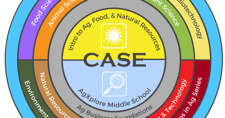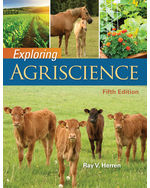Middle School Agriculture Curriculum: 3 Top Options
Coming from a family of educators, Brad knows both the joys and challenges of teaching well. Through his own teaching background, he’s experienced both firsthand. As a writer for iCEV, Brad’s goal is to help teachers empower their students by listening to educators’ concerns and creating content that answers their most pressing questions about career and technical education.
When teaching agriculture science in middle school, it’s essential to have the right resources for your students.
If you are starting a new program–or if your current resources have gone out of date–you’ll want to ensure your students receive an accurate, updated agriculture curriculum that will help them in their careers. After all, the right teaching materials can be the difference between students soaring ahead in high school or being unprepared to take that next step.
In this post, you’ll find three of the best middle school agriculture curriculum options:
- AgXplore Middle School from CASE
- Principles of Agriculture, Food, and Natural Resources from eDynamic Learning
- Exploring Agriscience from Cengage and National Geographic Learning
After reading, you’ll better understand what each curriculum provider offers to decide what’s best for your middle schoolers.
1. AgXplore Middle School from CASE

Curriculum for Agricultural Science Education (CASE) is one of the largest providers of agriculture education resources in the United States. Their AgXplore Middle School curriculum, often known as AgX, provides younger students with a thorough introduction to agriculture careers and the impact of agricultural technologies on society.
CASE AgXplore looks to engage students through various projects and hands-on activities while providing teachers with projects and assessment tools they can use to measure student progress. Among the resources available within AgX are learning games, questioning exercises, and laboratory projects.
The CASE curriculum provides about 50 instructional days' worth of material, enough to cover a typical agriculture science course at the middle school level.
Over the length of the course, AgX covers these eight topics:
- Ag in the Past
- Plants We Grow
- Resources We Use
- Resources We Recycle
- Energy We Consume
- Animals We Care For
- Food We Eat
- Ag in My Future
In addition, CASE includes resources for scaffolding instruction to individual student needs. The AgXplore Middle School curriculum aligns with state and national standards, including the National Agricultural Literacy Outcomes (NALO) alignment.
How Much Does CASE Cost, and Who Is It For?
CASE doesn’t disclose its curriculum pricing online, so you’ll have to contact them for how much it will cost your institution.
Be aware that you’ll need to attend a CASE Institute to use their curriculum in your classroom. These instructional seminars cost $1800-$3000 plus travel costs and are independent of the price of curriculum and classroom equipment.
CASE AgXplore is one of the best middle school agriculture curriculum options available. Not only does it provide a detailed look at agriculture careers, but it also provides students with an engaging experience to get them excited about future opportunities.
On the other hand, the additional requirement of attending a CASE Institute makes the curriculum more challenging to implement if you’re a new teacher or if you don’t have a lot of time to make changes to your agricultural science program.
2. Principles of Agriculture, Food, and Natural Resources from eDynamic Learning
eDynamic learning is a provider of CTE curriculum that has options for a middle school agriculture curriculum. Their Principles of Agriculture, Food, and Natural Resources course offers teachers and their students a broad overview of agricultural science as the basis for stewarding food and natural resources for the world’s growing population.
The eDynamic learning course gives students a comprehensive look at modern agricultural practices and the opportunities they have to make an impact in this career path.
The topics in the Principles of Agriculture, Food, and Natural Resources curriculum are divided into ten units:
- Careers in Agriculture, Food, and Natural Resources
- Leadership, Ethics, and Work Habits
- Agriculture, Food, and Natural Resources in Context
- Recordkeeping and Information Technology
- Plant Structures and Systems
- Understanding Animal Science
- Food Processing and Production
- Power, Structural, and Technical Systems
- Natural Resources Today
- Agriculture and the Environment
In addition to these topics, the course allows learners to conduct an agricultural experiment of their choice.
How Much Does eDynamic Learning Cost, and Who Is It For?
eDynamic Learning doesn’t provide pricing information for their courses on their site, so you’ll need to contact a sales representative if you want more information.
On the whole, Principles of Agriculture, Food, and Natural Resources is a robust option for a middle school agriculture curriculum. The course covers a diverse array of topics in detail, giving students plenty of background information when considering careers in agriculture.
Since there is so much detail here, it’s better for instructors who have more time to spend with their middle school students. Educators who are only interested in a simple introduction to agricultural science may want to choose a shorter curriculum resource.
3. Exploring Agriscience from Cengage and National Geographic Learning
Exploring Agriscience is a leading introductory textbook for agriculture science. Published as a joint venture between well-known CTE publisher Cengage and National Geographic Learning, Exploring Agriscience acquaints students with the many dimensions and opportunities within the agriculture science career pathway. Written by Ray V. Herren, the textbook is now in its fifth edition, which came to the press in 2017.
Exploring Agriscience covers a wide range of aspects of this important field, making it a valuable middle school agriculture curriculum resource.
The 608-page textbook includes 27 chapters on ag science topics:
- 1. The World of Agriculture.
- 2. The History of Agriculture.
- 3. Soil: The Origin of Life.
- 4. Plant Structures and their Uses.
- 5. Agricultural Pests.
- 6. Floriculture.
- 7. Nursery Production.
- 8. Landscaping.
- 9. Fruit and Nut Production.
- 10. Row Crops.
- 11. Forest Science.
- 12. Protecting the Environment.
- 13. Organic Agriculture.
- 14. The Livestock Industry.
- 15. The Dairy Industry.
- 16. The Poultry Industry.
- 17. The Science of Aquaculture.
- 18. Urban Agriculture.
- 19. Companion Animals.
- 20. Preserving our Food Supply.
- 21. The Ethical Treatment of Animals.
- 22. Selecting and Using Hand Tools.
- 23. Small Engine Operation.
- 24. Biofuels.
- 25. Biotechnology: The Future of Agriculture.
- 26. High School Agricultural Education Programs.
- 27. Careers in Agricultural Science.
This volume also includes a complete glossary of terms in both English and Spanish for student reference.
How Much Does Exploring Agriscience Cost, and Who Is It For?
Exploring Agriscience can be purchased directly from Cengage for $113 per copy. However, if you add the lab manual, you’ll have to pay an additional $116 per student for a total of $229. You can also give your students access to the digitally-based Cengage MindTap platform for an extra cost.
Overall, this collaboration between Cengage and National Geographic Learning results in a first-rate textbook for middle school agriculture. Between the lengthy text and accompanying lab manual, you’ll have more than enough material to teach.
Unfortunately, physical textbooks eventually become out of date. The most recent edition of Exploring Agriscience was published in 2017, making it significantly less current than the other options on this list.
Choose the Best Middle School Agriculture Curriculum for Your Students
When introducing your students to new career opportunities in agricultural science, it’s crucial to choose a curriculum that is engaging, comprehensive, and current. Updated and compelling resources will ensure your students have the best chance at understanding and coming to love opportunities in the agriculture pathway.
Depending on what you are looking for, any of the options in this post could be the right choice.
If you need a shorter agriculture resource for early middle school, consider CASE AgXplore.
If you want a more detailed, digitally-based resource, eDynamic Learning’s Principles of Agriculture course could suit your classroom.
And if you prefer a paper-based resource that covers agriscience comprehensively, the Exploring Agriscience textbook could be the right fit.
However, if you prefer a resource that introduces your middle school students to agriculture but also opens opportunities for learning throughout the agricultural science pathway, consider iCEV.
iCEV offers Agricultural Exploration as a middle school course as a first step in a comprehensive CTE program that culminates in certification testing. To learn more and to discover if iCEV is right for your program, visit the course page.
.jpg)

